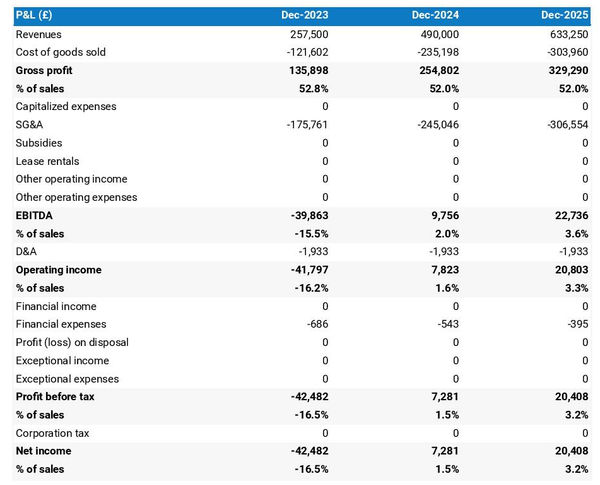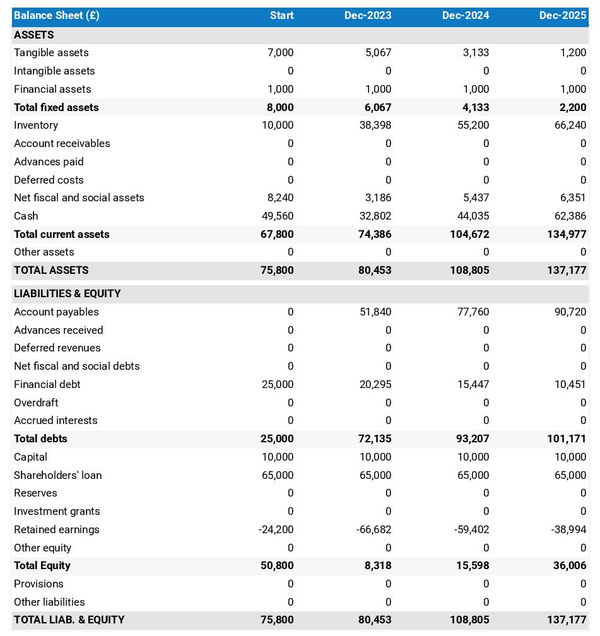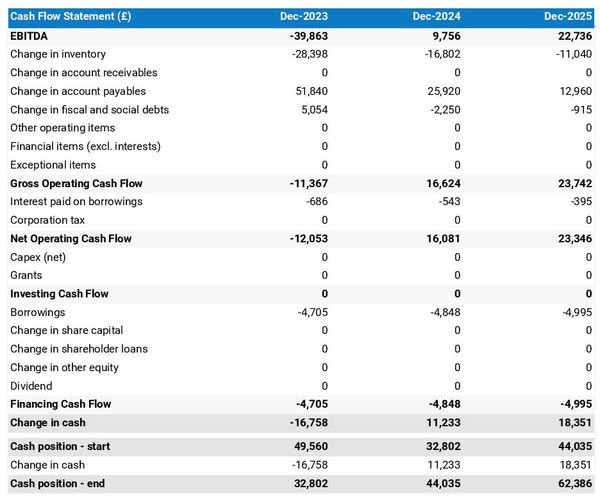How to create a financial forecast for a clothing line?

Developing and maintaining an up-to-date financial forecast for your clothing line is key in order to maintain visibility on your business’s future cash flows.
If you feel overwhelmed at the thought of putting together a clothing line financial forecast then don’t worry as this guide is here to help you.
We'll cover everything from: the main objectives of a financial forecast, the data you need to gather before starting, to the tables that compose it, and the tools that will help you create and maintain your forecast efficiently.
Let's get started!
Why create and maintain a financial forecast for a clothing line?
Creating and maintaining an up-to-date financial forecast is the only way to steer the development of your clothing line and ensure that it can be financially viable in the years to come.
A financial plan for a clothing line enables you to look at your business in detail - from income to operating costs and investments - to evaluate its expected profitability and future cash flows.
This gives you the visibility needed to plan future investments and expansion with confidence.
And, when your trading environment gets tougher, having an up to date clothing line forecast enables you to detect potential upcoming financing shortfalls in advance, enabling you to make adjustments or secure financing before you run out of cash.
It’s also important to remember that your clothing line's financial forecast will be essential when looking for financing. You can be 100% certain that banks and investors will ask to see your numbers, so make sure they’re set out accurately and attractively.
Need a solid financial forecast?
The Business Plan Shop does the maths for you. Simply enter your revenues, costs and investments. Click save and our online tool builds a three-way forecast for you instantly.

What information is needed to build a clothing line financial forecast?
The quality of your inputs is key when it comes to financial modelling: no matter how good the model is, if your inputs are off, so will the forecast.
If you are building a financial plan to start a clothing line, you will need to have done your market research and have a clear picture of your sales and marketing strategies so that you can project revenues with confidence.
You will also need to have a clear idea of what resources will be required to operate the clothing line on a daily basis, and to have done your research with regard to the equipment needed to launch your venture (see further down this guide).
If you are creating a financial forecast of an existing clothing line, things are usually simpler as you will be able to use your historical accounting data as a budgeting base, and complement that with your team’s view on what lies ahead for the years to come.
Let's now zoom in on what will go in your clothing line's financial forecast.
The sales forecast for a clothing line
From experience, it is usually best to start creating your clothing line financial forecast by your sales forecast.
To create an accurate sales forecast for your clothing line, you will have to rely on the data collected in your market research, or if you're running an existing clothing line, the historical data of the business, to estimate two key variables:
- The average price
- The number of monthly transactions
To get there, you will need to consider the following factors:
- You will need to consider the fluctuation of raw material costs, such as cotton and polyester, which may impact your average price per item and ultimately your profitability.
- The current fashion trends and consumer preferences will also play a significant role in your sales forecast. For example, if athleisure wear is in high demand, you may need to adjust your inventory and pricing accordingly to meet the market's needs.
- The overall economic climate can also affect your business's average price and number of monthly transactions. During a recession, consumers may be more price-sensitive, leading to lower sales and potentially lower prices.
- Your brand reputation and customer reviews can also impact your sales forecast. Positive reviews and a strong brand image can attract more customers and potentially increase your average price per item.
- The weather can also play a role in your sales forecast. For example, a particularly cold winter may increase the demand for winter clothing, while a hot summer may decrease the demand for heavy sweaters and jackets.
Once you have an idea of what your future sales will look like, it will be time to work on your overhead budget. Let’s see what this entails.
Need inspiration for your business plan?
The Business Plan Shop has dozens of business plan templates that you can use to get a clear idea of what a complete business plan looks like.

The operating expenses for a clothing line
Once you know what level of sales you can expect, you can start budgeting the expenses required to operate your clothing line on a daily basis.
Expenses normally vary based on how much revenue you anticipate (which is why, from experience, it is always better to start your forecast with the topline projection), and where your business is based.
Operating expenses for a clothing line will include some of the following items:
- Staff Costs: Includes salaries, benefits, and payroll taxes for employees working in production, design, marketing, and other departments.
- Accountancy Fees: Covers the cost of hiring a professional accountant to manage financial records and tax filings.
- Insurance Costs: Includes business insurance, liability insurance, and property insurance to protect against potential risks and damages.
- Software Licences: Covers the cost of purchasing and renewing licenses for necessary software programs, such as design software, inventory management systems, and accounting software.
- Banking Fees: Includes fees for maintaining a business bank account, wire transfers, and other banking services.
- Rent/Lease: Covers the cost of renting or leasing a physical space for a storefront, office, or warehouse.
- Utilities: Includes expenses for electricity, water, gas, and other necessary utilities for the business.
- Marketing and Advertising: Covers the cost of promoting the clothing line through various channels, such as social media, print ads, and influencer collaborations.
- Inventory Costs: Includes the cost of purchasing raw materials, finished products, and maintaining inventory levels.
- Shipping and Freight: Covers the cost of shipping products to customers, as well as receiving materials and products from suppliers.
- Professional Fees: Includes fees for hiring outside professionals, such as lawyers, consultants, and designers.
- Travel Expenses: Covers the cost of business-related travel, such as attending trade shows, meeting with suppliers, and visiting potential retail partners.
- Packaging and Labeling: Includes the cost of packaging materials, labels, and tags for products.
- Maintenance and Repairs: Covers the cost of maintaining and repairing equipment, machinery, and the physical space.
- Credit Card Processing Fees: Covers the fees associated with accepting credit card payments from customers.
This list will need to be tailored to the specificities of your clothing line, but should offer a good starting point for your budget.
What investments are needed to start or grow a clothing line?
Once you have an idea of how much sales you could achieve and what it will cost to run your clothing line, it is time to look into the equipment required to launch or expand the activity.
For a clothing line, capital expenditures and initial working capital items could include:
- Manufacturing Equipment: This includes machinery and tools used in the production process, such as sewing machines, cutting tables, and pattern-making software.
- Inventory: This includes the cost of purchasing raw materials and finished goods for your clothing line, such as fabric, zippers, buttons, and finished garments.
- Store Fixtures: If you plan on selling your clothing line in a physical retail store, you will need to invest in store fixtures such as racks, shelves, and display cases to showcase your products.
- Office Equipment: This includes items needed for administrative tasks, such as computers, printers, and office furniture.
- Transportation Vehicles: If you plan on shipping your products to customers or retailers, you may need to invest in a delivery van or other transportation vehicles to ensure timely and cost-effective delivery.
Again, this list will need to be adjusted according to the specificities of your clothing line.
Need a convincing business plan?
The Business Plan Shop makes it easy to create a financial forecast to assess the potential profitability of your projects, and write a business plan that’ll wow investors.

The financing plan of your clothing line
The next step in the creation of your financial forecast for your clothing line is to think about how you might finance your business.
You will have to assess how much capital will come from shareholders (equity) and how much can be secured through banks.
Bank loans will have to be modelled so that you can separate the interest expenses from the repayments of principal, and include all this data in your forecast.
Issuing share capital and obtaining a bank loan are two of the most common ways that entrepreneurs finance their businesses.
What tables compose the financial plan for a clothing line?
Now let's have a look at the main output tables of your clothing line's financial forecast.
The forecasted profit & loss statement
The profit & loss forecast gives you a clear picture of your business’ expected growth over the first three to five years, and whether it’s likely to be profitable or not.

A healthy clothing line's P&L statement should show:
- Sales growing at (minimum) or above (better) inflation
- Stable (minimum) or expanding (better) profit margins
- A healthy level of net profitability
This will of course depend on the stage of your business: numbers for an established clothing line will look different than for a startup.
The projected balance sheet
The projected balance sheet gives an overview of your clothing line's financial structure at the end of the financial year.
It is composed of three categories of items: assets, liabilities and equity:
- Assets: are what the business possesses and uses to produce cash flows. It includes resources such as cash, buildings, equipment, and accounts receivable (money owed by clients).
- Liabilities: are the debts of your clothing line. They include accounts payable (money owed to suppliers), taxes due and bank loans.
- Equity: is the combination of what has been invested by the business owners and the cumulative profits to date (which are called retained earnings). Equity is a proxy for the value of the owner's stake in the business.

The projected cash flow statement
A projected cash flow statement for a clothing line is used to show how much cash the business is generating or consuming.

The cash flow forecast is usually organised by nature to show three key metrics:
- The operating cash flow: do the core business activities generate or consume cash?
- The investing cash flow: how much is the business investing in long-term assets (this is usually compared to the level of fixed assets on the balance sheet to assess whether the business is regularly maintaining and renewing its equipment)?
- The financing cash flow: is the business raising new financing or repaying financiers (debt repayment, dividends)?
Cash is king and keeping an eye on future cash flows is imperative for running a successful business. Therefore, you should pay close attention to your clothing line's cash flow forecast.
If you are trying to secure financing, note that it is customary to provide both yearly and monthly cash flow forecasts in a financial plan - so that the reader can analyze seasonal variation and ensure the clothing line is appropriately capitalised.
Need a solid financial forecast?
The Business Plan Shop does the maths for you. Simply enter your revenues, costs and investments. Click save and our online tool builds a three-way forecast for you instantly.

Which tool should you use to create your clothing line's financial forecast?
Creating your clothing line's financial forecast may sound fairly daunting, but the good news is that there are several ways to go about it.
Using online financial forecasting software to build your clothing line's projections
The modern and easiest way is to use an online financial forecasting tool such as the one we offer at The Business Plan Shop.
There are several advantages to using specialised software:
- You can easily create your financial forecast by letting the software take care of the financial calculations for you without errors
- You have access to complete financial forecast templates
- You get a complete financial forecast ready to be sent to your bank or investors
- You can easily track your actual financial performance against your financial forecast, and recalibrate your forecast as the year goes by
- You can create scenarios to stress test your forecast's main assumptions
- You can easily update your forecast as time goes by to maintain visibility on future cash flows
- You have a friendly support team on standby to assist you when you are stuck
- It’s cost-efficient and much cheaper than using an accountant or consultant (see below)
If you are interested in this type of solution, you can try our projection software for free by signing up here.
Hiring a financial consultant or chartered accountant
Hiring a consultant or chartered accountant is also an efficient way to get a professional clothing line financial projection.
As you can imagine, this solution is much more expensive than using software. From experience, the creation of a simple financial forecast over three years (including a balance sheet, income statement, and cash flow statement) is likely to start around £700 or $1,000 excluding taxes.
The indicative estimate above, is for a small business, and a forecast done as a one-off. Using a financial consultant or accountant to track your actuals vs. forecast and to keep your financial forecast up to date on a monthly or quarterly basis will naturally cost a lot more.
If you choose this solution, make sure your service provider has first-hand experience in your industry, so that they may challenge your assumptions and offer insights (as opposed to just taking your figures at face value to create the forecast’s financial statements).
Why not use a spreadsheet such as Excel or Google Sheets to build your clothing line's financial forecast?
Creating an accurate and error-free clothing line financial forecast on Excel (or any spreadsheet) is very technical and requires both a strong grasp of accounting principles and solid skills in financial modelling.
Most entrepreneurs lack the expertise required to create an accurate financial forecast using spreadsheet software like Excel or Google Sheets. As a result, it is unlikely anyone will trust your numbers.
The second reason is that it is inefficient. Building forecasts on spreadsheets was the only option in the 1990s and early 2000s, nowadays technology has advanced and software can do it much faster and much more accurately.
This is why professional forecasters all use software. With the rise of AI, software is also becoming smarter at helping us detect mistakes in our forecasts and helping us analyse the numbers to make better decisions.
Finally, like everything with spreadsheets, tracking actuals vs. forecasts and updating your forecast as the year progresses is manual, tedious, error-prone, and time-consuming. Whereas financial forecasting software like The Business Plan Shop is built for this.
Need a convincing business plan?
The Business Plan Shop makes it easy to create a financial forecast to assess the potential profitability of your projects, and write a business plan that’ll wow investors.

Use our financial projection templates for inspiration
The Business Plan Shop has dozens of financial forecast templates available.
Our examples contain a complete business plan with a financial forecast and a written presentation of the company, the team, the strategy, and the medium-term objectives.
Whether you are just starting out or already have your own clothing line, looking at our financial forecast template is a good way to:
- Understand what a complete business plan should look like
- Understand how you should model financial items for your clothing line

Takeaways
- A financial forecast shows expected growth, profitability, and cash generation metrics for your clothing line.
- Tracking actuals vs. forecast and having an up-to-date financial forecast is key to maintaining visibility on your future cash flows.
- Using financial forecasting software is the modern way of creating and maintaining financial projections.
We hope that this guide helped you gain a clearer perspective on the steps needed to create the financial forecast for a clothing line. Don't hesitate to contact us if you have any questions!
Need inspiration for your business plan?
The Business Plan Shop has dozens of business plan templates that you can use to get a clear idea of what a complete business plan looks like.

Also on The Business Plan Shop
Know someone who runs a clothing line? Share our business guide with them!







